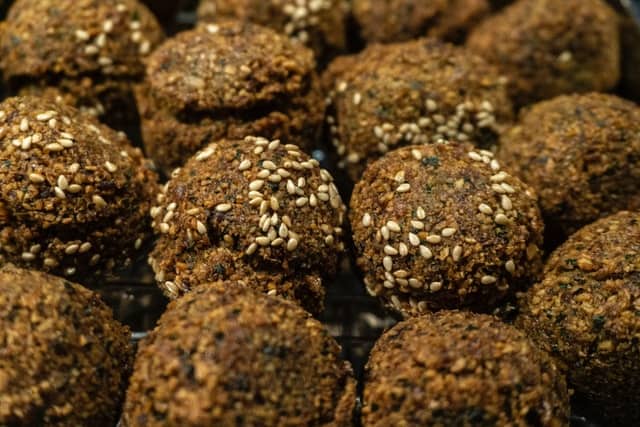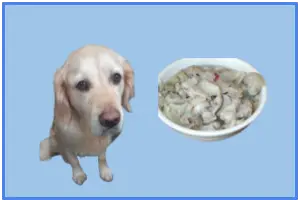
Falafel is a popular Middle Eastern dish, and is commonly seen as a street food.
Technically a falafel is a ball or patty shaped fritter made from either fava beans or ground chickpeas (or sometimes both) that has been deep fried, but they are often served in a pita which serves as a pocket or wrapped in a flatbread.
Because of this, the term “falafel” can sometimes refer to a wrapped sandwich that has been made in a similar way.
Either way, a falafel is a tasty snack and vegetarian friendly as an added bonus. All of this might make a pet owner ask the question, can my dog eat a falafel safely?
This article will answer that question so let’s get into it.
Can dogs eat a falafel?
Sadly the answer to this is no, a falafel is not a safe treat for your dog.
A falafel mix is made out of many ingredients, and among those ingredients are several that your dog can’t safely ingest.
The side effects could range from nausea and vomiting to more serious gastrointestinal problems.
We’re going to cover all of those ingredients so that you can look out for them in other foods that you might be thinking about feeding your dog since it’s always important to research first.
Because if there’s one thing that all pet parents know it is that we all just want to keep our little friends healthy and happy, and stomach issues brought on by something they weren’t supposed to eat wouldn’t make them very happy.
And in better news, one certain ingredient included in a falafel mix might be worth exploring as a treat on its own. I’ll get into that in a bit, and also tell you how and why you should prepare it for your pup.
What is a falafel?
And by this question you probably mean, what is in a falafel?
Most falafel mixes include the same ingredients so the ingredients that I’ll be listing off now are your standard ones, but of course you’ll want to check the ingredients in the mix you choose just to be sure there’s nothing different that you need to check out.
Different mixtures can have slight adjustments to the recipe which could include an ingredient or two that wasn’t covered here, so it’s better to be safe than sorry.
The standard falafel mix is made out of fava beans, chickpeas, spices, salt, garlic powder, onion powder, baking powder, (sodium acid pyrophosphate, sodium bicarbonate, cornstarch, monocalcium phosphate), dehydrated parsley, and sunflower oil.
Sometimes instead of salt the mixture could include sea salt specifically, but this doesn’t really change anything.
Are any falafel ingredients toxic for dogs?
Unfortunately one of the main ingredients for a falafel which is the fava bean is dangerous for dogs.
Fava beans, also known as broad beans, contain a compound called phytohemagglutinin (PHA) that can be toxic at high levels for dogs.
And even at lower levels can cause vomiting, diarrhea, and abdominal pain. So in short, it isn’t something you want to give your dog.
As far as the “spices” go, they could or could not be toxic depending on what they are.
Some spices can be fine for dogs to ingest while others such as onion, garlic, salt (and this also includes sea salt which is why I mentioned earlier that it doesn’t matter if it’s regular salt or sea salt that is listed in the ingredients), cocoa powder, and nutmeg are toxic to them.
And we know that salt, garlic powder, and onion powder are all a part of the falafel mix.
Parsley is okay to give dogs in small doses but can become dangerous in excessive amounts.
And baking powder shouldn’t be given to dogs since leavening agents can cause serious gastrointestinal problems for them.
What nutrition do chickpeas provide?
And now for the ingredient that I alluded to before, chickpeas.
You might have noticed that I didn’t list chickpeas as something that your dog shouldn’t eat, and that’s because chickpeas are perfectly safe for dogs.
Luckily,they are also very nutritious. In a 200 gram serving of chickpeas there are 12 grams of fat, 41 grams of protein, and 126 grams of carbs.
Additionally, chickpeas also contain a lot of vitamins and minerals that could boost your dog’s health such as fiber (which as an added bonus can help dogs feel full faster and for longer).
One last thing that is really cool about chickpeas is that they don’t contain any cholesterol, and can therefore help lower cholesterol levels in the blood.
Chickpeas are ideal for dogs with certain dietary restrictions due to all of these things.
If they’re dieting to lose weight then the fact that chickpeas fill dogs up faster will be helpful.
And it’s a good boost of protein for dogs in a limited ingredient diet to help with allergies especially if they’re protein allergies specifically.
And in the next section, I will look at a very popular food which is made from chick peas..
Can a dog eat hummus?
Hummus is a Middle Eastern dip that is often eaten with pita bread.
A typical ingredient list from a hummus mix would be: organic chickpeas, water, organic tahini, organic lemonjuice, organic sunflower oil, sea salt, organic dried garlic, organic cumin, citric acid, and ascorbic acid.
As you can see, chickpeas are the primary ingredient and for this reason you may be thinking that could be something you could give your dog.
The only problem is that a few of the ingredients in the mixture could be toxic to your pet.
You may have already noticed them since they’re the same ingredients that were included in the falafel mix that made that dangerous for dogs and these ingredients are sea salt and dried garlic.
And additionally the lemon juice and citric acid would be both bad and unenjoyable for your dog since dogs don’t really like the acidic taste of citrus.
Why is chickpea flour ideal for making dog treats with?
But just because hummus might not be an ideal food to give your dog, it doesn’t mean that we should give up on chickpeas entirely.
And in this section, I want to take a look at the power of chickpea flour…
In fact, chickpea powder is a good way to get all the nutritional benefits from the chickpeas while putting it in a form that dogs will always eat- dog treats.
All you have to do to add it to a recipe is substitute the chickpea flour for regular (plain) flour.
You won’t require as much chickpea flour so for every cup of regular flour only add three-fourths of chickpea flour.
It works in pretty much every recipe, and is a healthy substitute to introduce to your dog’s diet.Y
ou can generally find chickpea flour somewhere in your local grocery store, although it can vary from being in the gluten-free section, natural foods section, baking section, or even the international section since chickpea flour is most commonly used in Indian cuisine.
And if you don’t want to bother with buying chickpea flour then you can always get your hands on some dried chickpeas and grind them yourself in a food processor.
Keep in mind that if you grind the chickpeas yourself you may need to sift through the powder and re-grind the larger particles since dried chickpeas are usually quite hard.
By substituting chickpea flour for regular flour you’re not only making the treat gluten-free which is healthy in of itself but you’re also giving them all the added nutrients present in chickpeas including all of that healthy fiber.
That’s what we call a win-win situation, and I would suggest this method for anyone looking to make their dog’s snacks a little more healthy.
So even though your dog can’t have a falafel, I hope you’ve taken some positive news from this article.





